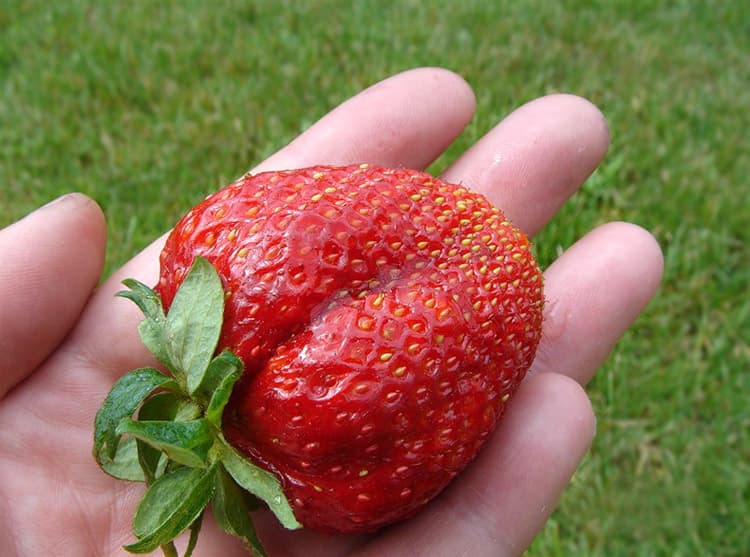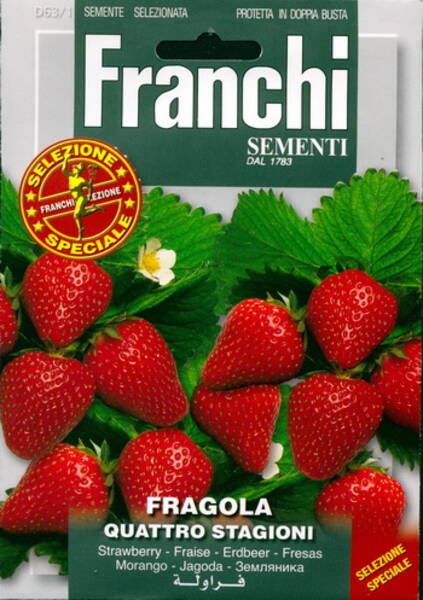This variety is a real "strawberry queen", tasty and healthy delicacy.
Its large berries with a strong aroma and taste are used fresh, for making jams, preserves, berry and fruit salads, compotes, fruit drinks and jelly.
Plants form a powerful bush up to 22-26 cm high, with large dark green leaves, moderate whisker formation and strong peduncles. The flowers are large, pale pink.
The berries are red, blunt-pointed, weighing up to 25-30 g, with a sweet and sour taste. The variety is hardy to adverse environmental factors, disease resistant.
When sowing, the seeds are mixed with sand and evenly distributed over a moistened flat surface.
Seedlings appear within 30 days. In the phase of 1-2 true leaves, seedlings dive into pots.

Sowing: the first stage is the preparation of the soil mixture: 3 parts of sand are mixed with 5 parts of humus. The humus should be crumbly.
The mixture must be heated in the oven for 3-4 hours, at 90-100°C. Sowing is carried out in February-March on the surface of slightly compacted and moistened soil.
A mixture of seeds and sand should be carefully placed on the resulting surface. Care must be taken to ensure that the seeds do not fall into the depths.
Seedlings may appear within 30 days, therefore, to accelerate seed germination, it is recommended to cover the seed box with a film and put it on the bottom shelf of the refrigerator with a temperature of +5 + 7 ° C for 2-3 days. Then place at +22°C for germination. In phase 1-2 of true leaves, seedlings dive into pots and reduce the temperature to +14+16°C.
After the appearance of true leaves in plants 6, it is possible to plant in the ground, with a distance between rows of 25-30 cm, between plants 15-20 cm.
January - February.
Leaving consists in snow retention: with lightly fallen snow, it is thrown onto the beds from the paths. Brushwood or, for example, raspberry branches are laid out on the beds so that the snow does not blow away.
March - April.
Usually the snow cover disappears by April 10-20, there may be thaws earlier. The main task is to break through the groove to divert the melt water from the plantations, and the strawberry bushes do not get wet.
When the snow finally melts, the soil thaws and dries a little, shelter (peat, branches) is removed from young plantings. The exposed roots are sprinkled with earth, humus.
If the plant, on the contrary, is "pulled" into the ground, then slightly raise it. Make sure that the heart (growth point) is at the level of the soil. On fruit-bearing beds, dry and diseased leaves are cut off with pruners from the bushes (this is also the prevention of gray rot). Attention! Green leaves are not removed.
Simultaneously with the cleaning of the site, loosening of the soil is carried out; strawberries, by the way, are very responsive to this procedure (at least 6 loosenings are carried out from April to October).
The plantation is not fertilized, since strawberries grow in one place for 3-4 years, and fertilizers are applied during planting. With an excess of fertilizers, the leaves grow rapidly to the detriment of the fruits.
When loosening, it is good to sprinkle the soil with wood ash. But if the plants overwintered poorly, then they can be lightly fed with a solution of nitrophoska or a fruit and berry mixture (1 tsp per 100 liters of water).
On old plantations, bushes are dug up, infected with a nematode (dwarf, twisted). If bushes infected with a tick are noticed (young leaves are shriveled, stunted), then it is necessary to carry out health watering. After the snow melts, but at negative temperatures, the bushes are watered with hot water (+65 ° C), 0.5 liters per plant.
To obtain an earlier harvest, the beds are covered with a plastic film, fixing it on low arcs. On hot days during flowering, the film is lifted, and with the start of picking berries, it is removed altogether. If frosts are expected, then a thin covering non-woven material is placed under the film: spunbod, lutrasil, agril. Frosts even at -1 degrees are sometimes fatal.
May.
The crucial moment during the flowering of strawberries is frost protection. To increase the yield and enlarge the berries, strawberry bushes are sprayed before the first flowers appear.
If it rained, repeat the treatment. During the flowering period, a terrible pest appears in strawberries - the strawberry weevil.
It is necessary to spray the plantings with a solution of garlic. From the garlic smell, the beetle flies away, but the effect lasts only two days. The procedure is repeated. If necessary, carry out a third time.
June.
Berry picking begins (from the 3rd decade of June). To prevent gray rot from the moment the berries are set, place dry chopped straw, shavings, wrapping paper under the strawberry bushes and lay black non-woven material along the rows. This will save both weeds and gray rot.
During the ripening of the berries, it is not recommended to loosen the soil so as not to pollute the berries and damage the flower stalks.
Until June 15, the planting of strawberries ends. The beds are prepared in 3-4 weeks, the earth is dug up and fertilized for 3-4 years.
Mustaches are planted in the mud, the soil is compacted. Make sure that the heart (growth point) is slightly above the soil level. Re-watering is necessary only after a week.
July.
Berry picking is over. Collect berries regularly, without overdosing them on the bush. For picking berries, it is better to use baskets and shingles (with a capacity of no more than 2-2.5 liters).
Do not pour the berries, do not injure them, and after picking, place in a cool place (where you store no more than 2-3 days). Eat berries fresh, process the excess.
Sick berries are collected in a separate bowl and burned. After the end of the collection, the bed is well shed and loosened.
If a tick is seen on the bushes (bushes are undersized, with shiny folded leaves), all leaves from the plantation must be cut and burned. Then pour over the bushes with hot water + 65 ° C (it is necessary to pour into the middle of the bush, 1/2 cup per bush) to kill the tick. This must be done before August, so that the young leaves have time to grow and the bushes get stronger. Then the plants are fertilized (1-2 teaspoons of complex fertilizer per bush), spilled with clean water and spud.
In healthy plants, the leaves are not cut off so as not to weaken the bushes, but watering, deep loosening, and mustaches are removed.
August - September.
Strawberry bushes are loosened, watered if necessary, from mid-August to mid-September, planting of the mustache ends. If the mustache is acquired later, they are added dropwise for the winter, and planted in the spring from May 1 in a garden bed prepared in the fall.
From September 15-20, mandatory watering of the fruit-bearing plantation is carried out, since at this time flower buds are laid for the future harvest. Appearing mustaches are removed.
October.
For a good wintering in a dry autumn, the plant is watered at the end of the month, the soil is loosened, weeds are weeded.
Plants spud or cover with humus, peat, compost. Branches of brushwood, raspberry stalks are harvested to cover the soil for the purpose of snow retention.
November.
After the soil has frozen to a depth of 5-8 cm, it is mulched with peat so that the plant does not push it out of the soil. Brushwood, raspberry stalks, Jerusalem artichoke leaves are laid out for snow retention.
December.
With a thin layer of snow on strawberry beds, it is increased by taking snow from the paths.












